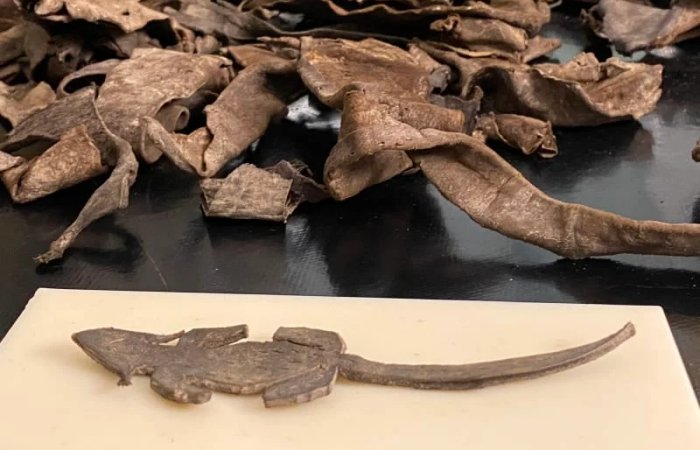Jan Bartek – MessageToEagle.com – Was it once a child’s toy or someone’s idea of a practical joke? We may never find an answer to this question, but the Roman leather toy mouse discovered at Vindolanda is fascinating.
The fort of Vindolanda, one of the earliest Roman garrisons, built by the Roman army in England, is one of Europe’s most important Roman archeological sites. It guarded the Stanegate, the Roman road from the River Tyne to the Solway Firth. It was situated behind Hadrian’s Wall, near the modern village of Bardon Mill in Northumberland, England.
Was this once a child’s toy? Credit: Vindolanda Trust
Archaeologists excavating at Vindolanda are rarely disappointed. Over the years scientists have unearthed thousands of ancient Roman objects at Vindolanda. The archaeological site is well-known for “its organic objects which includes the largest collection of leather boots and shoes in Roman Britain. In addition to the footwear the site has also revealed a substantial amount of tent panels, horse gear, patches, decorative embellishments, offcuts and scraps.” 1
When archaeologists uncover something of historical value, it often takes a long time before the artifact is cleaned, examined, categorized, and presented to the public. A while back, during the Covid lockdown, scientists could not excavate, and they used the time to examine the large ancient leather collection found at Vindolanda. While doing this they found this curious little ancient Roman animal. It’s a piece of leather that had been fashioned into a small animal resembling a mouse.
According to the Vindolanda Trust, “the mouse measures 12.2cm long and 2.6cm wide and has markings across the body to indicate the fur and eyes. The bag of scrap leather in which it was hidden inside was uncovered in 1993 during an excavation of a room inside the period IV/V Commanding Officer’s Residence, when the first cohort of Tungrains (from modern day Belgium) were stationed at the site. This dates the leather to c. AD105-130. It is thought it may have been a child’s toy, or possibly even used as a practical joke.
“One of the most wonderful things about the Vindolanda collection is that we never know what we are going to find next. Although we have a significant amount of evidence of children at Vindolanda we have very few toys, it would be wonderful if this little mouse had been a toy and a source of entertainment for a child here on the northern frontier,” the Trust’s Curator, Barbara Birley said.
Why the toy was made in the image of a mouse is unknown, but maybe because the animal was so common. According to researchers, real mice were present more or less everywhere, at the Vindolanda fort, as well as in all houses and other spaces.
“When the Vindolanda granaries were excavated in 2008, the bones from thousands of dead mice were uncovered below the floors of the building, where they had been living and feasting on the ears of grain that dropped between the flagstones.” 1
It is quite wonderful that someone 2,000 years ago crafted this toy mouse from leather, knowing their creation would not have sharp teeth nor eat them out of house and home.”
See also: More Archaeology News
Today mice remain, as they did 2,000 years ago, a pest to many people but one that we still have an affection towards. They are the source of many modern-day fictional characters for children, and it now seems that the affection is a timeless one.
It would seem that some things never change, and maybe they should not.
Written by Jan Bartek – MessageToEagle.com – AncientPages.com Staff Writer
Expand for references







